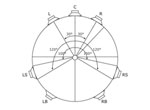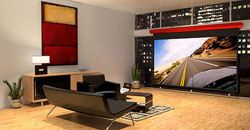Question:
Which is better for a home theater—a fixed or retractable projection screen? I’m interested in setting up a home theater and potentially having a retractable screen to make the room suitable for multiple uses, but I’m willing to make it a dedicated room if there are too many downsides to a retractable screen, such as maintaining the shape of the screen.
– Aleksander Pasko
Answer:
There are no downsides to retractable screens in terms of maintaining their shape or other performance issues; these screens use tensioning and other techniques to stay flat and wrinkle-free. The screen might become wrinkled if you don’t extend it fully, so be sure to carefully calculate how much black cloth (commonly called “blackdrop”) you need above the screen to bring the image area to the right height for your room. Fully extending the screen also assures that it will be properly aligned with the projected image every time.
The main drawback is cost. A retractable screen is more expensive than a comparable fixed screen—easily half again as much or more—and it requires more elaborate installation, typically hanging from the ceiling or even mounted within the ceiling, dropping through a thin slot into the room. Many motorized screens, such as the Stewart Cascade seen in the photo above, can be mounted on a wall or, in this case, a beam above a window. And don’t forget that all motorized screens require AC power, so you need to think about routing a power cord to them.
Aside from being less expensive, a fixed screen is much easier to mount on a wall or a freestanding frame. But it’s a big, blank surface in the room when not in use, and it is much more susceptible to damage from flying objects and clumsy people—a particular concern for families with small children.
You’re right that a retractable screen is better for a multipurpose room. Another great application is having the screen drop down in front of a flat panel—you can retract the screen and use the flat panel for more casual viewing, even in some room light, and drop the screen when you want to get serious about watching a movie in the dark. This type of setup also lengthens the life of the projector’s lamp because you’re not using it for all your video viewing.



